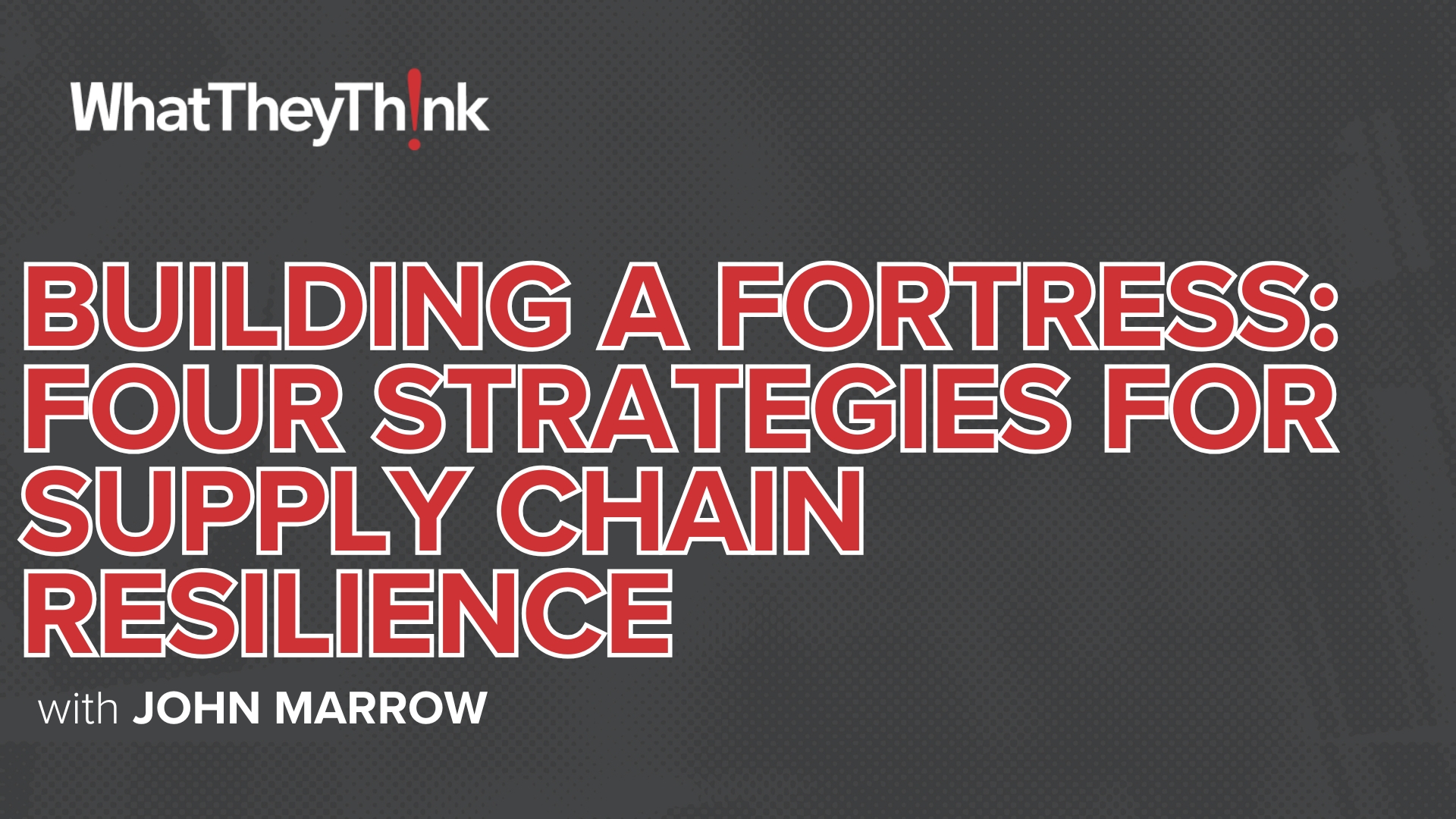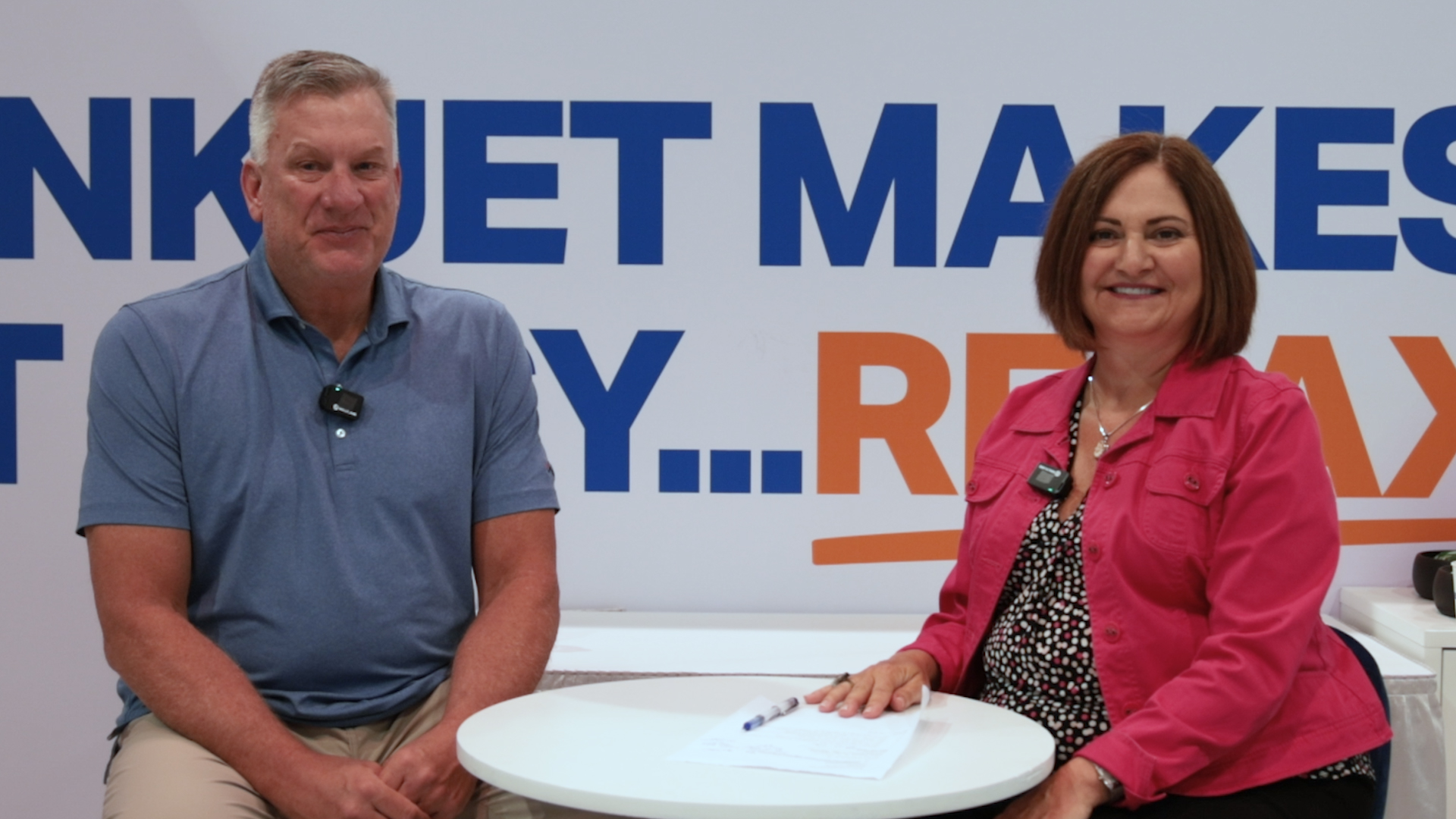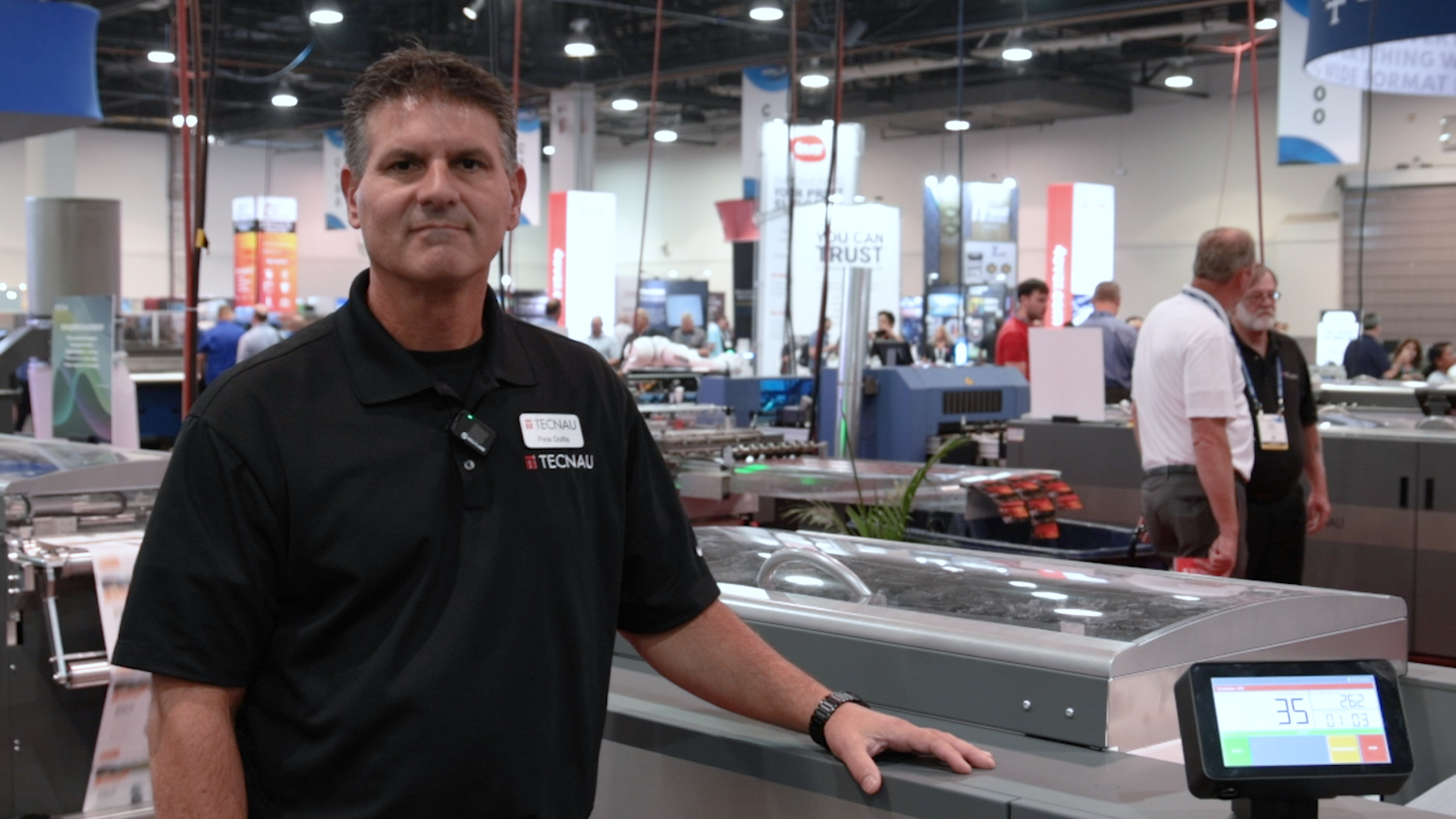Commentary & Analysis
Displaying 1651-1750 of thousands of articles
Insight You Need. Analysis You Trust.
Get the trusted insights you need to understand our evolving industry and emerging trends. Become a Premium Member.
Living Walls: Great Ideas for Transforming Spaces
Over the past three to four years, there’s been a surge in the use of living walls, also known as plant walls or green walls. These modern applications cultivate a feeling of well-being in any space. While popular, most versions of these walls need care and maintenance, requiring real soils, air, light and water. FASTSIGNS walks us through some of the types of these walls seen today.
Time to Talk Turkey About Sales—Part 1: Firing Customers and Avoiding Discounts
We use the phrase “let’s talk turkey” when Thanksgiving is just over a week away…or we want the other party to know that it’s time to get to the bottom line. As you look forward to 2022, Pat McGrew talks turkey about why this is a good time to think about the bottom line for your sales teams and how they interact with customers.
What You See Is What You Get. Or Not.
We’ve all been told not to rely on the color we see on our monitors because it’s not accurate. Most of the time that’s true, because most people don’t have capable devices or those devices configured properly. Dan Gillespie, Director of Technical Services at Alder Color Solutions, compares two monitors and explains how the accuracy of a display is a function of color gamut.
Strategic Focus: Omer Kulka Explains Kornit’s Shift of Focus and View of the Industry
Kornit Digital showed a 118% year-over-year revenue increase for the second quarter of 2021. The company also has shifted its strategy a bit and made a couple of acquisitions that reflect this shift. In this Executive Q&A, Chief Marketing Officer Omer Kulka shares insight about Kornit’s strategic focus and the state of the industry at large.
Moving Pictures: Automotive Wrap Applications Can Involve More than Cars
A photo gallery of recent vehicle wrap projects for private, commercial, and even aquatic vehicles.
First Class Mail? An Uncertain Outlook for Direct Mail in Europe
The COVID-19 pandemic dealt a blow to the direct mail market in Europe. However, there was already some pressure on parts of the market in the years before. European section editor Ralf Schlözer provides some details on market development and revenues achieved for direct mail in Europe.
September Shipments: We Got Good News and We Got Bad News
September 2021 printing shipments came in at $6.93 billion, up from August’s $6.87 billion. It’s not a massive increase, but we’ll take it. Year to date, January-to-September shipments are $60.48 billion, a bit off 2020’s January-to-September number of $60.97. Can we close the gap in Q4?
Around the Web: Better Breathing. Climate Catastrophe. Mrs. Mural. Tome Time. Phone Future. Zillow Zaniness. Tube Trouble. Bear Blending. Dead Doornails. Claus Crisis.
Robotic textiles that can help you breathe better. Fast fashion’s major manufacturing hubs may soon be under water. A robot painter sows the seeds of marital discord. A clock that displays the time using quotes from books. What will the smartphone of the future look like? The world’s first active heating fabric—thanks to graphene! An Indiana town is luring workers by offering free grandparents. Zillow shuts down doomed AI-based real estate valuation business. A “handheld toothpaste manipulation device” that will put toothpaste back in the tube, for some reason. Photoshopping Paddington Bear into every movie. The origin of the phrase “dead as a doornail.” The labor shortage is now getting real: there is a shortage of Santa Clauses. All that and more in WhatTheyThink’s weekly miscellany.
Not Fast Fashion—Extraordinary Fashion: Kornit Fashion Week Rocks Los Angeles to Deliver a New Future for Apparel Production
We talk a great deal about on-demand manufacturing in textiles and apparel, but it takes more than talk. Los Angeles Fashion Week may have been a tipping point between talk and action, according to on-demand apparel manufacturer Kirby Best. Why? Take a look at this article compliments of WhatTheyThink contributor and textiles expert Debbie McKeegan that demonstrates what can be done with digital technologies to change the way we think about—and produce—fashion.
What is the Metaverse, and Why Should Businesses Care?
The term “metaverse” is being thrown around a lot lately, but what does it really mean? When we hear tech evangelists discussing the metaverse today, what they’re really talking about is user-driven interactions within virtual realities. This article explores early examples of the metaverse and highlights why businesses should be paying attention.
Product Spotlight: Canon PRISMAprepare Go
Jennifer Matt takes an in-depth look at Canon’s PRISMAprepare Go pre-production workflow solution that can be deployed and optimized in a small print facility whose primary business is processing small “upload and print” orders.
What’s New with USPS Informed Delivery?
A look at the most recent USPS Informed Delivery update, including updated user stats, the latest open and click-through rates, and new features.
Don’t Get Spooked by Salespeople!
There are two sides to every sale: the buyer and the seller. Each party usually has the support of teams that help to solidify the requirements of the sale. hardware and software acquisitions are the result of long relationships with specific salespeople or the companies they represent—but that closeness can bring bias to the sales cycle. Pat McGrew explains how not to get spooked by the friendship.
Land The Big One: Three “Big Contract” Practices that Always Work
All salespeople want bigger contracts. Big contracts are the rising tide that floats all boats. But big deals can be complex, messy, and sometimes involve moving backwards to go forwards. Contributor Lisa Magnuson identifies three practices that always work.
The Target Report: The End of the Dotcom Era—October 2021 M&A Activity
HH Global Acquires Noosh, Allan Creel Jumps Back In, PE Still Loves Labels, and more…
Leading Textile Operations Provide a Template for Increasing Sustainability in the Industry
We always talk about the fact that the textiles industry is the world’s second largest polluter. Raising this awareness is helpful, but only if companies take the initiative to change the way they operate to reduce pollution, water and energy use, shipping, and transport, all while treating workers well and providing a living wage. In this article, we document some of those initiatives that can act as a template for others to follow.
Train Your Customers: An Educated Customer Is Your Best Customer
As the pandemic changes the print-buying environment, it becomes more important for customers to understand the new technology and business practices that make buying printing easier. Contributor John Giles explains how to train your customers and establish realistic expectations.
Printing On Glass: The View of the Future Is Bright with Inkjet Technologies
Over the years, many different methods have been used to decorate glass including painting, silk screen, sandblasting, etching, and decals and cling films—and of late inkjet technology has been increasingly used. David Zwang surveys the current state of direct-to-glass printing.
Around the Web: Robot Record. Living Lava. Digital Doors. Kooky Kafka. Goofy Glasses. Vaccine Vocab. Meta Misinterpretation. Clever Cards. Arrested Android. Truck Tech. Sustainable Spirit.
A writer, musician, and AI collaborate on a new album. Seen on Halloween: a human lava lamp. Replacing clear glass cooler doors with dynamic displays, for some reason. A recently unearthed collection of drawings shows a playful side of Franz Kafka. Good grief: are full-face sunglasses becoming a thing? The OED chooses its Word of the Year. Memo to Facebook: “Meta” is similar to the Hebrew word for “death.” MasterCard adds distinctive notches to its credit, debit, and gift cards for the visually impaired. Graphene integrated into trail running shoes. Ai-Da, an “artist robot” detailed in Egypt on suspicion of espionage. Air Vodka: “the world’s most sustainable spirit.” All that and more in WhatTheyThink’s weekly miscellany.
Paper Bag and Coated and Treated Paper Manufacturing Employment—2010–2019
According to County Business Patterns, in 2010, there were 50,879 employees in NAICS 32222 (Paper Bag and Coated and Treated Paper Manufacturing establishments). This NAICS category peaked two years later at 54,175, declined slowly over the rest of the decade before shooting back up to 51,811 employees in 2019. In macro news, Q3 GDP growth is up 2.0%.
Are You Noticing More Holiday Catalogs This Year? You’re Not Alone!
I’ve noticed an uptick in the number of holiday catalogs I receive in the mail, but I wasn’t sure if it was just me. This article explores the changing role of printed catalogs and considers what the future might hold in today’s highly digital world.
3D Printing Shifts into Fourth Gear: It’s Time to Increase 3D Printing in Automobile Manufacturing
3D printing is accelerating in the auto industry, shifting from prototyping and tooling to finished parts. Manufacturers of consumer, commercial and military vehicles are producing original and replacement parts with plastic and metal. Contributor Pete Basiliere looks at growth trends in automotive 3D printing.
Three Ways to Prepare Cotton and Viscose Fabrics for Brighter, Sharper and More Cost Effective Inkjet Printing
Proper fabric preparation can maximize the intensity and brilliance of the printed colors and control how the ink spreads on the fabric, optimizing printing definition and delivering a better-looking end product to delight brands and consumers. As brands and designers increasingly look for ways to use cellulosic fibers such as cotton and viscose, Huntsman Textile Effects offers good advice in this article provided compliments of Texintel.
Root Cause Challenges in Print Software
Sometimes the way you’ve been managing your core business data in your Print MIS/ERP is fundamentally broken. This has a ripple effect across your business, so it’s worth the effort to clean it up. Stop ignoring the crack in your business foundation.
Are Workload Challenges Affecting Your Employees?
Workplace satisfaction matters. Unhappy employees equal higher turnover. Higher turnover equals higher HR costs and, especially in the printing industry, real concern about the ability to fill open positions. A workplace satisfaction survey from Parallax, while focused on the digital services industry, shines a spotlight on issues that many other employers should consider, including those in the printing industry.
Vehicle Visions: The Role of Textiles in Today’s Automobiles
You might be surprised at the volume and type of textiles being used in today’s vehicles—including woven, knitted, and nonwovens. Cary Sherburne takes nonwoven fabrics for a test drive, and identifies business opportunities—perhaps not so much in mass manufacturing of automobiles, but in customization of vehicles, which is growing in popularity.
drupa Essentials of Print: What’s Holding Back Digitally Printed Packaging?
It may sound unnecessarily provocative to suggest that digital print in packaging has failed to fulfil expectations, but some of the more idealistic predictions of digital conquest have not yet come to pass. What are the reasons for this? And is the post-COVID world closer to the tipping point? Tim Sykes, Brand Director at Packaging Europe, explores the barriers that may be holding back the digital tide.
A Bright Outlook for Book Printing and Publishing
At the Frankfurt Book Fair 2021, Intergraf, the European trade association for printing, held a conference on book printing and publishing. Book printing is one of the bright spots among established print applications with increasing sales of printed books. Still, there are a couple of changes in store and several speakers shared their insights. European section editor Ralf Schlözer reports on the outlook for book printing and publishing.
Labels and Packaging: Luxe Pack Sets the Tone
Label and packaging procurement reached new heights during the pandemic, and as a result, while there may not have been many live events this year to showcase the latest trends in label and packaging, hardware manufacturers and software developers have been busy—and the industry has been humming along.
Lessons from The Jetsons...and How to Become a Digital Boss
Learning and using modern technology is particularly important in design and publishing today as most industries are struggling to hire people due to a national labor shortage. There is the need to train new workers not just in how to use their devices and applications, but how to streamline their computer usage to get the most efficient work possible. Guest contributor Laura Moynihan, Director of Digital Helpmates, sheds light on the issues of learning and using modern technology.
Koenig & Bauer: Powering Through the Pandemic with a Wide Range of New Products
Koenig & Bauer just reported one of their best years ever, despite the difficulties of the pandemic, and is looking forward to good momentum going into next year. In this interview, Cary Sherburne talks with Kilian Renschler, the new President & CEO for the Americas, as well as Senior Vice President of Marketing Eric Frank, to get the latest details.
Print Industry Looks to a Lower Carbon Future
While there remains much uncertainty in the print industry after two years of unprecedented disruption, one of the strongest emergent trends post-pandemic has been the interest in more sustainable print processes. Smithers editor John Nelson summarizes these issues in this article featuring highlights from the latest Smithers study “The Future of Green Printing Markets to 2026.”
Tripping the Light Fontastic: We Just Hit the One-Millionth Digital Font
In this article and accompanying video, Frank celebrates the release of the one-millionth digital font, looks back at the evolution of typeface design and distribution, and provides a comprehensive list of sources of digital fonts.
Around the Web: Blue Blues. Token Tracking. Prince Printing. Diminished Denim. Fridge Flaming. Golden Graphene. Mountain Messaging. Munster Music. Silly Strings. Festive Franks.
The latest supply chain victim: blue paint. Adobe Photoshop to add “Prepare as NFT” option. 3D printing system maker Stratasys partners with Prince’s Paisley Park. Making denim production more sustainable. Amazon is now a bigger shipper than FedEx. You can now get nasty emails from your refrigerator. Graphene + gold = smart windows. Interesting facts about “It’s the Great Pumpkin, Charlie Brown.” A lost hiker ignores calls from rescuers. A long lost musical album from The Munsters. Hot dog-flavored candy canes. All that and more in WhatTheyThink’s weekly miscellany.
September Graphic Arts Employment—Print Production Up, Non-Production Down
In September 2021, all printing employment was up +0.8% from August, production employment up +1.1%, and non-production printing employment up +0.3%.
Photo Printing Market after COVID-19: Data and Trends
The global pandemic has turned the entire economic order upside down without sparing the photo printing industry. All previous forecasts turned out to be simply inadequate to the new challenges. This article, written and sponsored by Printbox, discusses how the sales of photo products changed from 2019 to 2020, how the lockdown influenced the behavior and preferences of consumers, and the post-pandemic trends that will affect sales in 2022.
Designer Q&A: Meet Irene Van Ophoven and Her Stunning Interior Products that Push the Established Boundaries of Design
In this piece, textiles expert and WhatTheyThink contributor Debbie McKeegan interviews Dutch designer Irene Van Ophoven about her journey to establishing her own design studio, including how digital technologies have enhanced her ability to create innovative, stunning designs.
A Great Customer Experience: It’s All About Balance!
It is now more important than ever for providers of transactional communications to deliver the positive experience that their customers have come to expect. Keypoint Intelligence’s newly released transactional communications survey data confirms that a positive customer experience can be a compelling competitive differentiator in today’s market.
Print Production Outlook: Takeaways from the October 6 Webinar (Part 2)
Part 2 of a two-part series based on the What They Think webinar “Print Production Outlook: Tracking the Turning Points.” In Part 1, presenter German Sacristan of Keypoint Intelligence analyzed Keypoint and other data on the industry’s growth and key turning points, including the shift to high-speed inkjet. In Part 2, Sacristan analyzes the current and future state of industry applications, as well the state of packaging and labels.
Your Existing Technology Stack Matters
Your existing technology stack should be one of the most important factors in making decisions about new software solutions and new automation projects.
European Print Industry Snapshot: Greece
In this bimonthly series, WhatTheyThink is presenting the state of the printing industry in different European countries based on the latest monthly production numbers. This week, we take an updated look at the printing industry in Greece.
Driven to Distraction: Display Graphics and Signage in the Automotive Industry
When we think of display graphics in the automotive industry, the first thing that springs to mind is vehicle graphics. But display graphics are taking on new roles as a subset of experiential or environmental graphics for auto dealer showrooms. As the auto sales experience is changing post-COVID (as are so many things), and more auto sales move online to sites like Carvana, display graphics are also in a state of flux.
Johnson’s World—Bad Data Needs a Scrub: Clean up Your Data Before It Takes You to the Cleaners
Steven Johnson shows how customization and personalization based on bad data can lead to ill will, poor publicity, and even lawsuits.
Print and Automotive: Two Industries Driving Innovation in Customer Engagement
During the pandemic last year, auto sales dropped radically and innovative auto direct mail campaigns geared down. Fast-forward 16 months and the situation is very different, as more and more people head back out on the road. Joanne Gore looks at how printers, automobile brands/dealers, media agencies, and tech companies are teaming up to create engaging and innovative marketing campaigns for automobiles—and driving business.
SwagCycle: It’s All About Landfill Divergence for Textiles
Among the many sustainability issues the textiles and apparel industry is facing, textile waste in landfills is near the top of the list. In this article, we talk with Ben Grossman about SwagCycle, his attempt to give back with a goal of landfill divergence for textile-based products, contributing to a reduced footprint and increased circularity.
Other Paperboard Container Manufacturing Employment—2010–2019
According to County Business Patterns, in 2019, there were 18,741 employees in NAICS 322219 (Other Paperboard Container Manufacturing establishments), a drop from 21,954 employees a year earlier, and the lowest ebb for this NAICS category. In macro news, new business formation goes “bezonkers.”
Around the Web: Fruit First. Font Follies. Public Papers. Graphene Gums. Android Artist. Resignation Reality. Pulling Plastic. Citation Silliness. Toy Telephony. Venerable Venue. Spider Sleepwear.
Fun facts about the word “orange.” A 1909 patent for a font that can be read either from left to right or right to left. How typeface choice can impact learning and comprehension. Public radio may help save newspapers. Graphene’s uses in dental applications. Meet the Flingbot and its approach to abstract art. What’s behind The Great Resignation? An approach to removing ocean plastic that just might work. A traffic camera confuses a T-shirt with a license plate. Fisher Price’s classic Chatter Telephone can now make real calls, terrifyingly. A new book celebrates the Fillmore East. Get comfy in (or terrified by) giant tarantula pillows. All that and more in WhatTheyThink’s weekly miscellany.
When to Use Rotary Screen Printing and When to Choose Digital Textile Printing with SPGPrints
As more companies in the textile and apparel industry look to digital printing for more efficiency and a smaller environmental footprint, it can be confusing to determine exactly where digital textile printing fits. In this guest post from SPGPrints, compliments of Debbie McKeegan and Texintel, Jos Notermans highlights seven different factors that help with that decision process.
Tilia Labs: Reaching Maximum Velocity with Intelligent Printing
Small print jobs have been on the rise, even as many of the pre-production processes have remained unchanged. This article explores how intelligent planning software solutions like those from Tilia Labs can help PSPs better manage the influx of smaller jobs and optimize print production.
Improving Profits through Employee Engagement
You already measure important KPIs in your business. You look at your financials and monitor things like cash position, inventories, age of receivables, maintenance records, equipment productivity, daily production output, etc. When was the last time you measured employee engagement? Wayne Lynn explains how people are the core asset of your business, and why it may be time you started learning much more about them.
Print Production Outlook: Takeaways from the October 6 Webinar (Part 1)
Part 1 of a two-part series based on the WhatTheyThink webinar “Print Production Outlook: Tracking the Turning Points.” In Part 1, presenter German Sacristan of Keypoint Intelligence analyzes Keypoint and other industry data on the state of the industry’s growth and key turning points.
Assessing the Validity of a “Must-Have” Software Feature
“Must-have” features typically are not worthy of holding up a launch or delaying the utilization of software. The best way to assess the importance of features is to start using the software, then you stop assessing “theoretical” importance.
Reanimating the Customer Experience: Like a Good Movie, Give Your Customers an Immersive Experience
Customers seek an immersive experience orchestrated by authentic people that consistently delivers. Do this well and you will build long-lasting, predictable customer relationships. Do this poorly and the discontinuity of an unpredictable experience will churn customers out of your portfolio. Contributor Preston Herrin evaluates two types of customer context: “New” and “Nurtured.”
Haunting Tales of Sales
As we enter the final months of the calendar year, companies are wrapping up their fiscal year and trying to get sales to close—which can lay the infrastructure for misunderstandings and mistakes. Pat McGrew identifies two common scenarios that can haunt you for a long time after the sale.
Big “L” or Little “l”—Either Way, Companies Love Latex
Since 2008, latex printers have offered a highly flexible alternative to solvent printers, as they could print on a wide variety of materials, including textiles. In this feature, we look at some users of latex doing creative work for wallcoverings, display graohics, and...voting boxes?
The New Convergence: Trends in the Maturing Online Print Market
Online printers have carved out a big share of the print business today and their revenue share is set to increase. This is partly driven by new companies starting up with an online business model, and partly by traditional printing companies moving into online print. European section editor Ralf Schlözer looks the post-pandemic status of online print.
August Shipments: Summer Ends on a High Note
August 2021 printing shipments came in at $6.87 billion, up from July’s $6.47 billion. Year to date, January-to-August shipments are $53.42 billion, not far off 2020’s January-to-August number of $53.68.
Around the Web: Polar Publication. Robotic Writing. Waymo Weirdness. Restaurant Robots. Perilous Punctuation. PURE Processes. Nightmare Nanas. Marvelous Mollusks. Canine Carrier.
A deluxe print edition of the story that inspired The Thing. A 14-foot long robotic pen. Waymo’s self-driving cars are flocking to a dead-end street in San Francisco—and no one knows why… A Paris restaurant replaces its chef with a robot. The Casa Grande (Ariz.) Neon Sign Park. The lack of an apostrophe in a Facebook rant gets an Australian man sued. Apps that delete words from stories leaving just the punctuation. Graphene-enhanced bed sheets. PrimaLoft improves its manufacturing technology for insulation used in garments. China’s “Grannies from Hell.” Hand-crocheted plush octopuses. “The Schnauzer Chariot of Kazakhstan.” All that and more in WhatTheyThink’s weekly blasting Shatner into space miscellany.
“Creatives In Residence Live”—Meet the Graduates and Follow the Curriculum via Online Learning
As we have been discussing in this space, attracting new talent to the textiles and apparel industry is a key challenge. The industry is quite different than it was 40 years ago! Yet it still has a reputation from those days. UK firm CMYUK is making a contribution with its Creatives In Residence program. In addition to winners learning with hands-on experience at the firm, anyone can join the learning virtually. We need more programs like this! Meet the winners and learn more about the program.
Making Sense of Your Print Options
With so many available options, deciding which print solutions to incorporate into your business can be an overwhelming task. By identifying your business priorities and assessing which companies and technologies best align with these priorities, you can better determine which technologies and services are best for you and your customers.
Web-to-Print Product Spotlight: MyOrderDesk by Print Reach
Jennifer Matt takes an in-depth look at Print Reach’s MyOrderDesk, a product that has not only stood the test of time but has now become a foundation block in Print Reach’s automation strategy, with a feature set that clearly reflects a product that has evolved with the times and continues down that path.
USPS’ Informed Delivery Full-Color Marketing Option: Is it Worth It?
The United States Postal Service’s Informed Delivery Service is not only growing in subscribers, but it is expanding in services. Its interactive campaigns now offer marketers the option to replace the grayscale scan automatically provided with the service with a full-color “representative” image of each mail piece instead. But is this an option that mailers should rush to embrace?
Digital Packaging: Kodak Ups the Ante Again…
Kodak has been successfully operating a transformation strategy that has shored up the company while investing in innovation in their core strengths of print (with an emphasis on digital), advanced materials, and chemicals. With the introduction of an EP press designed for folding carton, packaging, and retail POP, Kodak expands their existing packaging portfolio options to a wider audience.
Look at That: Leveraging the Power of Embellished Print Marketing
In this application photo gallery, Trish Witkowski displays some great examples of embellished self-promotional pieces across several categories, including direct mail, packaging, and promotion.
European Print Industry Snapshot: Austria
In this bimonthly series, WhatTheyThink is presenting the state of the printing industry in different European countries based on the latest monthly production numbers. This week, we take an updated look at the printing industry in Austria.
Is the Apparel Industry Stepping Up to Climate Challenges?
As we look ahead to the upcoming COP26—UN Climate Change Conference of the Parties—in November, it’s a good time to take a look at some of the developments in textiles that will help the industry move forward in a more sustainable fashion. Just Style hosted a COP26 apparel panel discussion to explore these moves and we summarize here.
Security Print For Packaging: New Opportunities Post-COVID
As print markets adjust to new realities in 2021, there is interest in diversification into security and brand protection features for packaged goods. Smithers editor John Nelson looks at some security printing trends highlighted in the recent Smithers report “The Future of Anti-Counterfeiting, Brand Protection and Security Packaging to 2026.”
Folding Paperboard Box Manufacturing Employment—2010–2019
According to County Business Patterns, in 2010, there were 30,048 employees in NAICS 322212 (Folding Paperboard Box Manufacturing establishments). Employment in this category stayed fairly steady throughout the decade, then spiked in 2019 to 47,980 employees. In macro news, sales of light vehicle sales plummeted in September 2021, even as profits reached record highs.
Around the Web: Facebook Fail. Book Blobs. Rogue Reader. Book Boxes. Wonder Waste. Mask Museums. Chromosome Capers. Composer Cash. Beethoven’s Back! Strava Sketches. Dish Disaster.
The latest trend in book cover design. A DIY “open source ereader.” A new subscription service for under-appreciated books. “The digital death of the collector.” Turning waste into graphene. Celebrating masks. Biohacking DNA to take over gene sequencing computers. How much would Bach make on Spotify? AI helps Beethoven finish his Tenth Symphony. A gallery of “Strava art.” An ill-advised vending machine for china. All that and more in WhatTheyThink’s weekly fat bear miscellany.
The Target Report: Private Equity Fuel$ Consolidation of Label Industry—September 2021 M&A Activity
Resource Label Group Acquires Ample Label, Kennedy Group Purchases Color Label Business, Postal Center International Buys Arrowmail, and more…
Nearshoring: Poland Becomes a Leading Supplier of Digital Print for EU Textile Companies
Sustainability is a hot topic in textiles and apparel. One move that is set to help reduce the carbon footprint for the industry is reshoring—producing goods closer to the point of need—which reduces transportation costs and can include establishment of microfactories utilizing digital rather than the often more wasteful analog manufacturing processes. Find out how and why Poland is leading the reshoring charge in Europe in this guest article provided compliments of textiles expert and WhatTheyThink contributor Debbie McKeegan.
Take One and Pass the Rest On: Print-Based Learning Remains Important in Today’s Classroom
Although there is no question that digital learning is playing a bigger role in education than ever before, printed materials remain critical to learning. This article explores why print-based lessons remain a cornerstone of education in the modern classroom.
Would Your Customers Rather Have a Tooth Pulled Than Do Business with You?
According to a new survey by Insightly/Zogby Research, consumers would rather have a tooth pulled, learn a TikTok dance with their kid, and wait in line at the DMV than resolve an issue with a company’s customer service department. Why? Because companies are over-confident in their customer relationships and are more interested in talking than listening.
The Great Asset Shortage: Get Creative to Cover Staffing Shortfalls
Finding qualified workers has long been a challenge for the printing industry, a problem only exacerbated by the pandemic. Contributor Lou Caron looks at how we as an industry need to build general public awareness and become experts at hiring.
Is There a Workaround?
You can use software as it was designed, or you can stand your ground and request workarounds to force the software to work like you do today. Your flexibility has a greater impact on your business outcomes. Using that flexibility to optimize software utilization is the most powerful lever in your toolbox.
American Litho Turns to HP PageWide Production Inkjet for Increased Flexibility, Productivity
In this article sponsored by HP, Mike Fontana, CEO of Illinois-based American Litho, explains the decision process behind acquiring two HP PageWide Production Inkjet Presses and the value the company has received from its investments. The ninth largest US direct mail producer touts quality, speed, and support as key decision factors.
Do You Have a Sales Dashboard?
Sales teams are under increasing pressure to handle more accounts, grow those accounts, and deliver on margins. As a result, sales performance software has become a huge business. Pat McGrew rounds up some leading sales dashboard applications.
Label Congress 2021: Surprisingly Well Attended and Informative
While Label Congress was a relatively small event, it appeared to be a very successful one. With a comprehensive educational conference schedule and a small but active expo hall, it delivered what was promised to the exhibitors and, more importantly, to the attendees.
In a Dynamic European Publishing Industry, Print Proves to Be Resilient
Publishing is a major source of print demand and a thriving publishing industry will benefit print as well. Traditionally, both industries relied very much on each other. Like printing, publishing is also now deeply affected by electronic channels and changes in consumer behaviour. European section editor Ralf Schlözer takes a look at the state of the European publishing industry.
Digital Unboxing: Packaging Experiences an Innovation Collision
Throughout the industry, from brand identity and messaging to converting and distribution, digital capabilities cause processes in every part of the packaging supply chain to be re-evaluated. Mary Schilling explains how the presence of digital print technology has created stellar opportunities for label, folding carton, and flexible packaging.
August Graphic Arts Employment—Staying on the Plateau
In August 2021, all printing employment was up +0.4% from July, production employment up +0.4%, and non-production printing employment also up +0.4%.
Around the Web: Domestic Droid. Drone Deterrents. Crazy Calculator. Graphene Grab. Wet Wires. Tag Tech. Furry Financier. Robotic Recaps. Conference Closets. Jean Genie. Spreadsheet Stage.
Amazon’s new “household robot.” Raven vs. Drone. A calculator that converts normal units to wacky units, such as llama’s spits or bees. The “wonder material” poses national security issues. A 3D map of all the underwater Internet cables. A robot built to spray graffiti. “The world’s first crypto asset trading hamster.” Using AI to summarize books. Are “Zoom booths” in offices likely to be a thing? (We hope not.) How to reduce the environmental impact of your jeans. “I’m not sure Google Sheets is the best way to experience theater.” All that and more in WhatTheyThink’s weekly miscellany.
Leveraging Growing 3D Investment Beyond Design for Volume and Speed
In the fashion industry, it's been like long-distance runners who have time to finish the marathon. But now they realize they need a sprint. In this article, written by Yoram Burg of Embodee and provided courtesy of Debbie McKeegan, textiles expert and WhatTheyThink contributor, the role that 3D can play in fashion, beyond simply design, is explored and explained.
Adapting to a Hybrid Workflow: An Essential Checklist
For those businesses that are considering the transition to a hybrid workflow, it is important to understand the IT and security risks involved. This article describes the components of a successful hybrid workflow and explores the role that print will play.
Trends in the New Normal: Changing Consumer Behaviors Are Driving Change In-Store
While the pandemic created many challenges for printers, it also brought opportunities. Some of them were passing, but many will stay with us into the new normal. In this article, sponsored by FLEXcon, Jodi Sawyer explains how being flexible and willing to reimagine businesses to support trends such as BOPIS, digital advertising, and sustainability will be critical for printers to stay relevant moving forward.
The Automation Journey
Automation is about changing a business process. Focus on the business process, involve the people operating the business process today. Keep full automation as a goal, drive incremental improvement as the strategy.
USPS Informed Delivery Growing Quietly
In case you haven’t noticed, the USPS’s Informed Delivery (ID) program has been growing quietly but steadily. It has grown not only in numbers, but also in trust among ID users. Features have been enhanced, and more PSPs are quietly promoting it as an extra value to their customers.
Prime Rate Pursues a Digital Future with HP PageWide Web Press T240 HD
Tomcsányi Péter, CEO and Founder of Prime Rate, a printing firm located in Hungary, started his journey as a book author looking for a publisher and ultimately ended up starting his own printing company. In this article, sponsored by HP, Péter has been expanding Prime Rate’s digital capabilities by installing HP PageWide Web Presses and converting his entire digital color operation to an HP platform.
Smithers Identifies Leading Factors Driving Shorter Print Orders to 2031
As the industry now looks to achieve a degree of normalcy in the post- COVID world, print orders will become smaller and more frequent. This means print service providers (PSPs) must be more agile and responsive, while for OEMs it is creating a new emphasis on digital print technology and customer support services. This is the subject of a new Smithers report, Impact of Changing Run Lengths on the Printing Market. This article offers some highlights from that report.
The Rise Of Hybrid And Bespoke: Production Design by Application
Digital technologies in print and finishing are in a continuing race against market shifts—and vice versa. David Zwang explains how both hybrid and bespoke print solutions will play an increasing role, and why we are in for some interesting times.
What Drives Your Business? It All Comes Down to a Balancing Act
There is no single driver for a successful business. It always requires a balance. But balance is easiest on a strong foundation, and the best foundation is good people. Contributor Dave Fellman discusses how most printers don’t put enough emphasis on the quality of their human resources.
Challenges and Opportunities in the Sewn Products Industry
The pandemic placed stress on most industries, but arguably one of the most affected was the sewn products industry, which was already facing challenges pre-pandemic. In a recent interview, Senior Editor Cary Sherburne discussed the state of the sewn products industry with SPESA President Michael McDonald and steps that could be taken to ameliorate those challenges.
Change Is Hard, but So Is Winning
From sales to estimating to order entry, Modern Litho’s processes had been steeped in manual touchpoints, and they realized that they needed to upgrade their front-end technology. In this article, sponsored by Kodak, Modern Litho’s Jeff Davidson chronicles the company’s search for and implementation of a new MIS.
Corrugated and Solid Fiber Box Manufacturing Employment—2010–2019
According to County Business Patterns, in 2010, there were 84,136 employees in NAICS 32221 (Corrugated and Solid Fiber Box Manufacturing establishments). Employment in this category dropped abruptly in 2012, then continued to rise over the course of the decade, peaking in 2018 at 88,399 before dropping again in 2019. In macro news, three estimates of Q3 GDP.
Around the Web: Paint Power. Getting GO. Follicle Flora. Luminous Leaves. Simplifying Sneakers. Computer Covers. Peculiar Posters. Card Carriers. Worm Wiki. Avocado Art. Butt Biometrics.
Scientists have invented a white paint that cools the surface ton which it is applied. Unlocking a mystery of graphene oxide. How to make a living, growing plant-based wig. Scientists create rechargeable light-emitting plants using nanoparticles. Nike develops easy-to-put-on sneakers for people with disabilities. Relive old memories with a gallery of classic 1980s and 90s computer book covers. AI-generated movie posters. Etsy shops now offer a variety of vaccination card holders. A surprisingly extensive list of fictional worms. The impending age of the smart toilet and your—ugh—“analprint.” All that and more in WhatTheyThink’s weekly miscellany.
The Paradox of Organization
In the last stage of the process of getting things done we confront the issue of Organization. Being organized and flexible at the same time can be maddening. Without this behavioral competency we can make great decisions on a routine basis and have them fail continually. Wayne Lynn explains why.
Developing High-Impact Direct Mail for All Ages
Direct mail is a key component of the print spectrum, and its importance will only grow as high-speed color inkjet devices bring new levels of quality and productivity to this market. Sending the right promotions to the right consumers can have a significant impact on their purchasing decisions. This article explores the role that age plays in developing high-impact direct mail that gets noticed.
What’s Behind the Transformation in Industrial Digital Textile Printing
Thanks to textiles expert and WhatTheyThink contributor Debbie McKeegan, and Tim Phillips of IMI Europe and Catenary Solutions for this informative article that explains the drivers behind the transformation underway in the textiles industry with respect to industrial digital textile printing.
Johnson’s World—Dear Mr. Schwab: Choose Print
Steven Johnson takes stock of Charles Schwab & Co’s recent decision to replace its printed “On Investing” magazine with an email blast, and provides Mr. Schwab with several reasons why it’s a bad investment.
Study: Don’t Have Great Tracking and Reporting? Print Quality and Service May Not Save You
“Enhancing the Print Customer Connection,” a new report from NAPCO Research/Canon USA, 2021, finds that print quality and customer service may not help printers hold onto customers the way they think. Print management, tracking, and reporting tools may be equally or even more important.
- Questions to ask about inkjet for corrugated packaging
- Can Chinese OEMs challenge Western manufacturers?
- The #1 Question When Selling Inkjet
- Integrator perspective on Konica Minolta printheads
- Surfing the Waves of Inkjet
- Kyocera Nixka talks inkjet integration trends
- B2B Customer Tours
- Keeping Inkjet Tickled Pink
© 2024 WhatTheyThink. All Rights Reserved.














